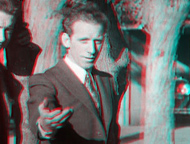 |
| Peter Anderson ACE (photo credit Justin Edward Lake) |
Stereographer pioneer and guru Peter Anderson’s Masterclass on Sunday night (June 12th) was as much a visual trip through his 3-D photo scrapbook as it was a Stereoscopic primer (and it certainly provided some wonderful basics). Although the nostalgic slideshow offered Mr. Anderson a chance to brag it also provided 3-D enthusiasts a chance to see equipment and gear that few been able to. We were also treated to some incredible clips for his work including (Weird) Al’s Brain in 3D (2008) and David Arquette’s The Butler’s in Love (2009). Kudos to Peter for hanging around Toronto until Monday night and adding extra insight into other speaker’s sessions via his questions and comment. (Including being able to comment on U23D with it’s director Catherine Owens in the room).
Monday's discussion focused primarily on the history of 3-D cinema, with it's beginnings in the stereoscope (the Victorian equivalent of the viewmaster) to the inclusion of 3-D images on the zoetrope, placing the origin of stereoscopic cinema at the very birthplace of moving pictures. The speakers then covered the history of 3-D film in often tangential topics such as Hitler's use of 3-D motion picture cameras at the 1936 Summer Olympics, it's use in the General Motors booth at the 1939 New York World's Fair, and Canada's earliest contributions via the National Film Board and animator Norman McLaren's short films that screened during the 1951’s Festival of Britain. While interesting presentations, the historical section of the Conference, aside from the most casual mention, mostly omitted discussions of any features produced in 3-D between 1950-2000. There was no discussion of Arch Obler, Tony Anthony, Julian Roffman or any of the pioneers who came before this present era of digital 3-D. Only Alan Silliphant (director of 1969's The Stewardesses) got a mention from Stereo 3D Unlimited’s Tim Dashwood, naming him as a mentor and that was on Tuesday’s Independent 3-D Film Discussion’s panel.
Regrettably I had to skip the Resident Evil screening and post mortem as well as the last day’s screening of Hubble 3D (and IMAX 3D pioneer Graeme Ferguson’s keynote).
What I did manage to get to that day involved a lively discussion of stereoscopic moving images as art. Although the last day featured the smallest attendance I believe that much of what was explored in these final sessions remains key to elevating stereoscopic cinema from a mere theme park attraction. Cinema itself, being a mere century old, has had its grammar and language explored by the artists creating movies and scholars for much of its life, yet 3-D cinema is rarely been explored outside of conventional cinematic notions. The 3-D film is still waiting for an Orson Wells (or perhaps Wenders) to elevate the technology and tell a story that the audience couldn’t imagine without the 3-D process being involved.
The discussion will continue here and I'm sure I will be referring back to the 2011 Toronto International Stereoscopic 3D Conference throughout the next year.
The discussion will continue here and I'm sure I will be referring back to the 2011 Toronto International Stereoscopic 3D Conference throughout the next year.

